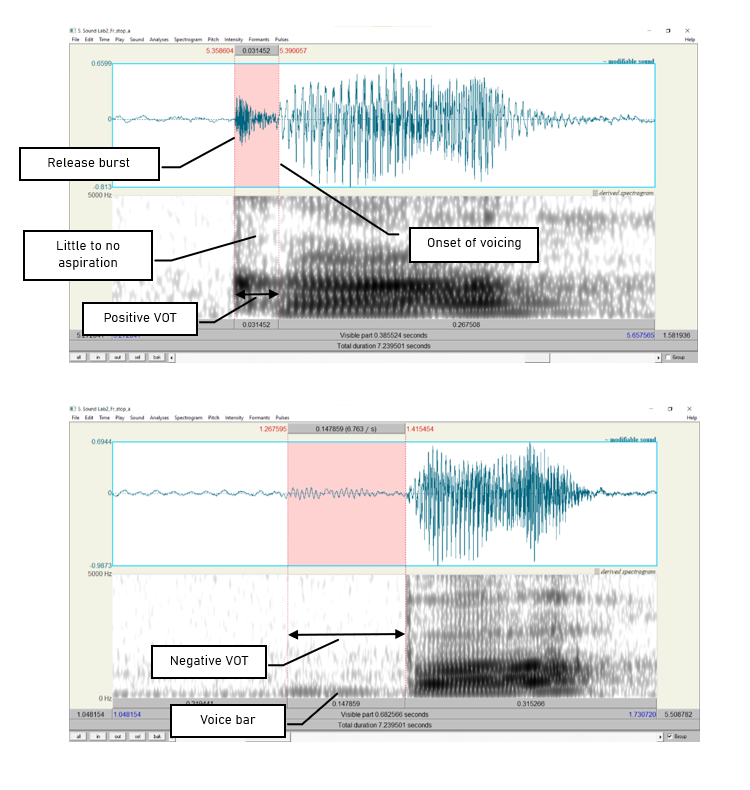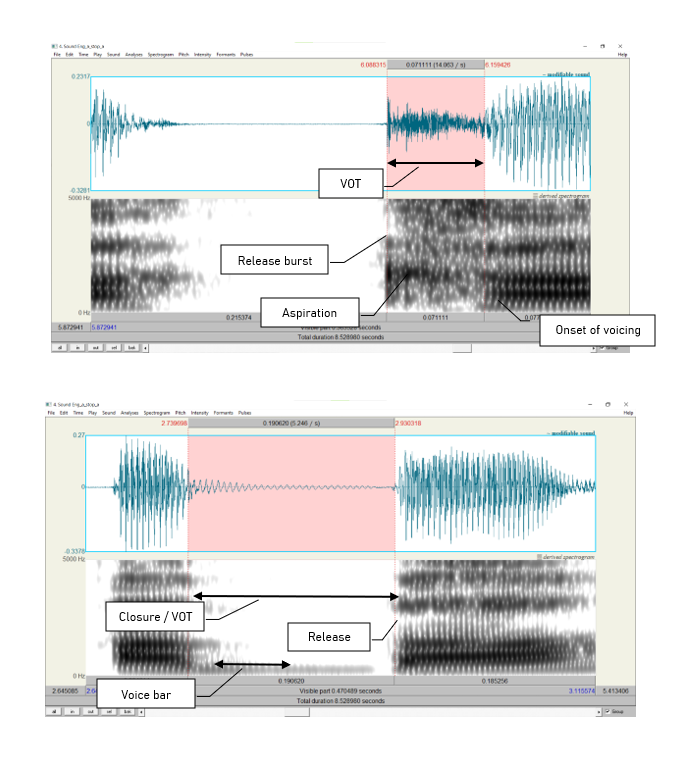Lab 2: Voicing in stop consonants
Thomas Kettig, based on work by Sonya Bird et al.
Goal of Lab 2:
One of the most common acoustic features that is measured and manipulated in speech research is voicing in stop consonants (in particular voice onset time). In this lab, we are going to explore the acoustic correlates of different stop consonants in terms of two parameters: voicing and place of articulation.
RECORDING
Generate the following sound files containing the sequences listed in the right column, and save them with the file names provided in the left column. You may also choose to use the Lab 2 English files contained in our “Lab sound files” folder on eClass. Make sure that in your lab report, you specify whether you recorded the files yourself or chose to use the pre-recorded eClass ones.
| File name | Sounds to record |
|---|---|
| Lab2_Eng_stop_a.wav | pa, ba, ta, da, ka, ga |
| Lab2_Eng_a_stop_a.wav | apa, aba, ata, ada, aka, aga |
| Lab2_Eng_a_stop.wav | lap, lab, bat, bad, rack, rag |
If you are an L1 French speaker, also generate the following
sound files. Otherwise, go to eClass and download the Lab 2 French files
from our “Lab sound files” folder. Make clear in your lab report whether
you’ve used the pre-recorded files or generated your own. (Don’t worry
that the pre-recorded a_stop ones are nonce words rather than the real
ones I suggest in the right column; the initial consonant shouldn’t make
much difference in terms of what you’ll need to measure for the a_stop
files.)
| File name | Sounds to record |
|---|---|
| Lab2_Fr_stop_a.wav | pa, ba, ta, da, ka, ga |
| Lab2_Fr_a_stop_a.wav | apa, aba, ata, ada, aka, aga |
| Lab2_Fr_a_stop.wav | nappe, nab, latte, lad, sac, vague |
Three important acoustic correlates of voicing in stops are:
- The voice bar
- VOT
- The duration of the preceding vowel
For each of the stops in each file, take measurements according to the instructions below and fill out Table 2.1, Table 2.2 and Table 2.3 accordingly. Answer the related questions by comparing your measurements across stops.
INSTRUCTIONS
- Open the following sound files in Praat: “Eng_stop_a.wav” and “Fr_stop_a.wav”. Measure the VOT of each stop (see Figure 2.1) and fill in Table 2.1. Compare voiced/voiceless counterparts (p/b, t/d, k/g):
- Zoom in so that you can clearly see the transition between the stop
and vowel.
- Measure the time between the end of the stop closure ( = the
beginning of the release burst) and the onset of voicing ( = the onset
of regular pitch pulses in the waveform). This is the voice onset time
or VOT.
- If the onset of voicing follows the release of the
stop clouse, then VOT is calculated as positive; stops
with positive VOT are termed voiceless.
- VOTs of 0ms to about 20ms or 30ms correspond to voiceless unaspirated stops.
- VOTs above 20-30ms correspond to voiceless aspirated stops.
- If the onset of voicing precedes the release of the stop closure, then VOT is calculated as negative; stops with negative VOT are termed prevoiced or more generally, voiced. (See bottom of Figure 1.2).
- If the onset of voicing follows the release of the
stop clouse, then VOT is calculated as positive; stops
with positive VOT are termed voiceless.

TIP:
Praat reports time values in seconds, but in phonetic analysis we report in milliseconds, so the values need to be converted. Once you have converted to milliseconds, you do not need to report any decimal places.
Also remember that you might want to change the dynamic range from its default setting of 70dB to 50dB in Spectrogram > Spectrogram settings. This helps to remove background noise that might otherwise look like a voicing bar.
- Open the following sound files in Praat: “Eng_a_stop_a.wav” and “Fr_a_stop_a.wav”. Note in in Table 2.2 of your report the presence vs. absence of the voice bar (see Figure 2.2) during the stop closure of each consonant and, if present, how long the voice bar lasts.

- Open the following sound files in Praat: “Eng_a_stop.wav” and “Fr_a_stop.wav”. Measure the duration of the vowel preceding each stop, and fill in Table 2.3 in the report. Compare vowel durations in the voiced vs. voiceless series.
TIP: In order to measure the duration of the vowel, you will need to identify the section of the sound which makes up the vowel. One common means of doing so is to measure where there are clearly visible vowel formants in the spectrogram. You may also find that the waveform helps you see where the vowel’s periodic, high-intensity sound waves begin and end. Whatever method you use, the most important thing is to be consistent and use the same method for all your measurements.
LAB 2 REPORT
You may work in pairs for this lab. On eClass, submit: 1) all .wav files you created for this lab (but not ones you downloaded from eClass) and 2) a PDF with filled-in tables and answers to the questions below. Make sure the PDF file name follows the convention LING4220_Lab2_LastName_FirstName.pdf or, if submitted as a pair, LING4220_Lab2_LastName1_FirstName1_LastName2_FirstName2.pdf. If submitting as a pair, only one person in each pair should submit the .wav and .pdf files.
Table 2.1 VOT
| p | b | t | d | k | g | |
|---|---|---|---|---|---|---|
| English VOT (ms) (Eng_stop_a) | ||||||
| French VOT (ms) (Fr_stop_a) |
Q1: How does VOT differ between voiced vs. voiceless stops? How do English and French seem to differ in terms of how they use VOT as a cue to voiced vs. voiceless stops?
Table 2.2 Voice bar
| p | b | t | d | k | g | ||
|---|---|---|---|---|---|---|---|
| English voice bar (ms) (Eng_a_stop_a) | Is it there? | ||||||
| How long does it last? | |||||||
| French voice bar (ms) (Fr_a_stop_a) | Is it there? | ||||||
| How long does it last? |
Q2: If the voice bar is present at all, does it last through the duration of the closure? Why do you think it might go away?
Q3: What differences (if any) do you observe in the voice bar between English and French?
Table 2.3 Preceding V duration
| p | b | t | d | k | g | |
|---|---|---|---|---|---|---|
| English preceding V duration (ms) (Eng_a_stop) | ||||||
| French preceding V duration (ms) (Eng_a_stop) |
Q4: How does the duration of the preceding vowel differ depending on the voicing of the following consonant?
Q5: What differences (if any) do you observe in the preceding vowel duration between English and French?
Q6: Based on what you’ve seen in this lab, summarize the possible acoustic correlates of the phonemic voicing contrast (voiced vs. voiceless) across languages.
REFERENCES
Q7: Provide a reference and very brief (one paragraph) summary of one academic paper that uses the methods covered in this lab.
Disclaimer: The original lab materials on which this lab is based were put together in 2015 (updated 2019) by Sonya Bird, Qian Wang, Sky Onosson, and Allison Benner for the LING 380 Acoustic Phonetics course at the University of Victoria. Their materials are released under a Creative Commons license (CC BY-NC-SA 4.0) which allows for non-commercial use as well as copying and distribution and the creation of derivative works for non-commercial purposes. Thomas Kettig (with assistance from Taylor Potter) has modified these materials as needed for the York University LING 4220 Acoustic Phonetics course.